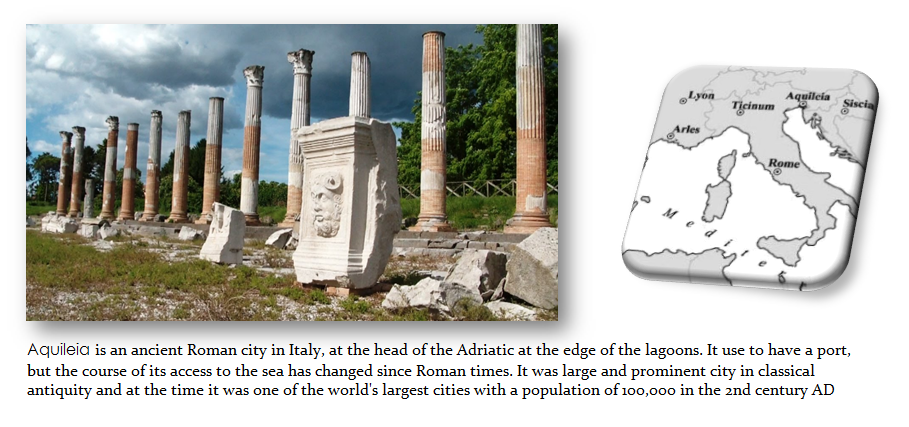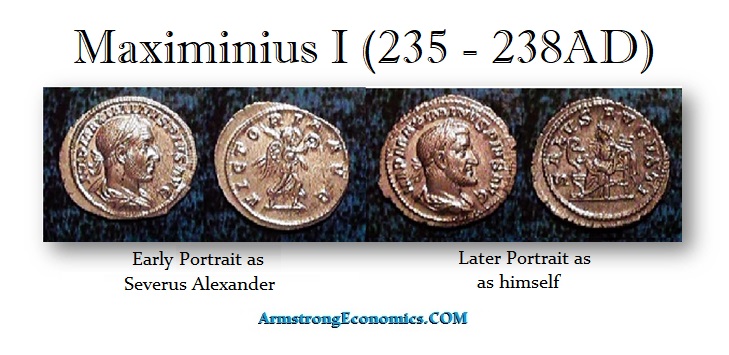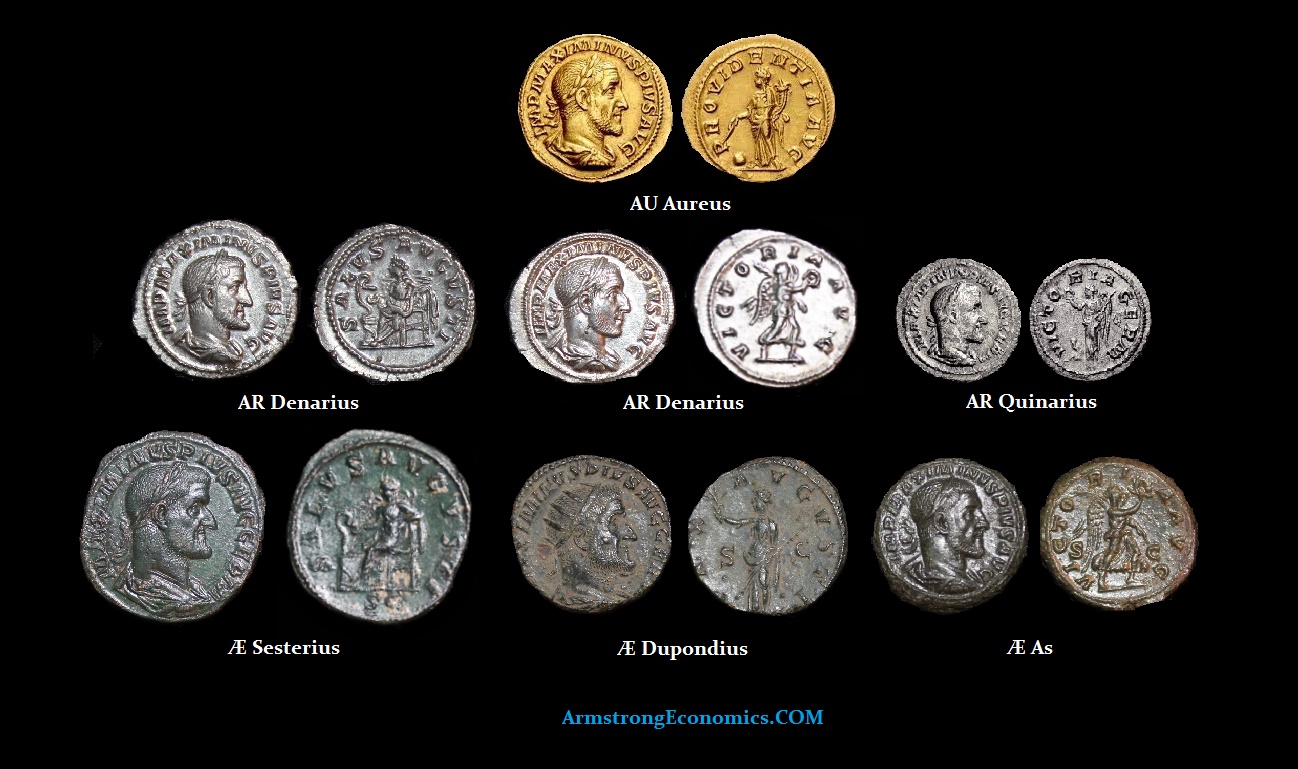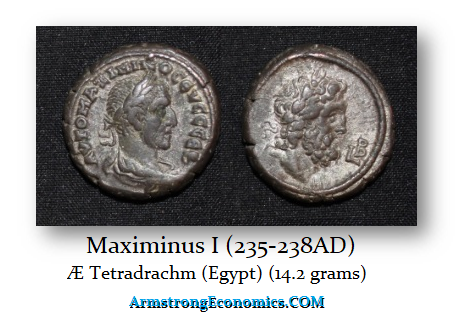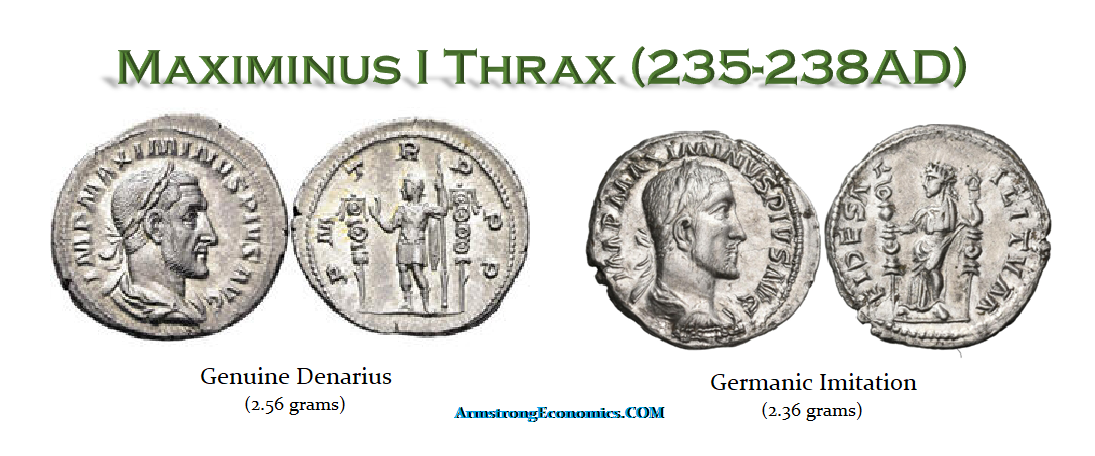Maximinus I
235-238 AD
Maximinus I (235-238AD) is said to have been the first soldier who rose through the ranks to become Emperor. He was also from Thrace in Greece and is said to have been a shepherd before joining the army. With Hindsight, many considered that he was really a barbarian whose parents merely crossed the border into Thrace, unable to rationalize his behavior as a Roman citizen. This was largely a position taken to explain what appeared to be an intense hatred of Rome itself. Under Severus Alexander (222-235AD), he had risen to command the Army of the Rhine. Severus and his mother were murdered while in Germany at Moguntiacum (Mainz). The Rhine Army then proclaimed Maximinus I Emperor of the Roman Empire.
Obviously, the Decline and Fall of Rome were underway. When an emperor tried to reduce government expenditure, the troops often rioted. Sometimes they would murder the presiding emperor, such as Pertinax (193AD) and Macrinus (218AD). It was in 238AD that a group of landowners rebelled against the rising imperial taxation, killing the tax collectors. As taxes and government expenditure rose, things were just nuts.
Maximinus I rising through the ranks as a soldier was a natural selection for government employees demanding money. He took the approach of a government employee. He by no means sought to reduce the pay of government employees; instead, he raised taxes to pay for his troops and even went much further. Maximinus’ three actions against the people were very Marxist in those days regarding ALL wealth now belonging to the state! He was desperate for money, and those rich bastards would cough up everything! This caused money to be hoarded. The economy’s decline from there took 31.4 years (Pi Cycle) to collapse. As money went into hiding, it never returned in force. The collapse of Rome picked up steam.
Maximinus had doubled the soldiers’ pay, and the military needed additional funds for road-building to maintain control. He also appropriated ornaments from public places and temples. Can you imagine the government coming into your church and taking anything of value to pay for government employee wages? This led to a great tumult resulting in many massacres in defense of religion. In opposing those who had supported Emperor Severus Alexander, Maximinus I ordered Christians to be persecuted.
Maximinus I used Conspiracy, a crime still used by the United States yet abandoned in Europe, Russia, and China. Conspiracy is the law of tyrants, for it allows the conviction of someone for a crime they did not commit, nor even attempted to commit but you claim they “intended” purely as a mental state to commit in the future. Maximinus I engaged in legal persecution. Thus, the criminal law became:
(1) committing the act, (2) attempting to commit the act, and then (3) there is Conspiracy which is claimed you have only “intended” to commit the act in your mind, which cannot be proven and typically requires extorting a confession by force.Using conspiracy, the law of tyrants, Maximinus I effectively tore the Roman economy apart at its seams. He charged a noted Senator by the name of Magnus, with conspiracy against the emperor, found him guilty, executed him, and then arrested 4,000 others claiming they conspired with him to intend to depose him. He then used criminal law to claim they had committed a conspiracy, and that, of course, justified confiscating all their property as well.
The second act of Maximinus I was to declare that all wealth belonged to the emperor in a communistic fashion. What took place, however, was the complete breakdown of society. Wealth was driven underground, and money was hoarded, causing VELOCITY to collapse as cash flow in circulation vanished and hoarding prevailed. This caused the economy to implode as commerce ceased, fostering an economic depression that naturally reduced tax revenues. Maximinus I did not stop with simply private wealth. Maximinus I ordered the wealth of all temples to be confiscated as well. Countless died in defense of their religious beliefs. Not even the gods were respected by Maximinus I, whose view was that they never answered prayers because they did not exist.
Where there had once been golden statues of former Emperors, Maximinus ordered their seizure so they could then be melted down. The Rule of Law collapsed, and Historia Augusta tells us that he -“condemned all whoever came to trial” and that he “reduced the richest men to utter poverty.” The USA conviction rate today is about 99%. The courts abandoned the people as they have done so again in the USA. There was truly nothing left. Nowhere could a person turn for justice. With the people under siege from their own government, they hoarded wealth to conceal it from state spies. This caused a collapse in VELOCITY of money flow as commerce foundered, sending the economy into a Great Depression spiral. This was open warfare against the possession of wealth. Edward Gibbon wrote in his Decline and Fall of the Roman Empire regarding Maximinus I:
“As long as the cruelty of Maximin[us I] was confined to the illustrious senators, or even to the bold adventurers, who in the court or army expose themselves to the caprice of fortune, the body of the people viewed their sufferings with indifference, or perhaps with pleasure. But the tyrant’s avarice, stimulated by the insatiate desires of the soldiers, at length attacked the public property. Every city of the empire was possessed of an independent revenue, destined to purchase corn for the multitude, and to supply the expenses of the games and entertainments. By a single act of authority, the whole mass of wealth was at once confiscated for the use of the Imperial treasury. The temples were stripped of their most valuable offerings of gold and silver, and the statues of gods, heroes, and emperors, were melted down and coined into money. These impious orders could not be executed without tumults and massacres, as in many places the people chose rather to die in the defence of their altars, than to behold in the midst of peace their cities exposed to the rapine and cruelty of war. The soldiers themselves, among whom this sacrilegious plunder was distributed, received it with a blush; and hardened as they were in acts of violence, they dreaded the just reproaches of their friends and relations. Throughout the Roman world a general cry of indignation was heard, imploring vengeance on the common enemy of human kind; and at length, by an act of private oppression, a peaceful and unarmed province was driven into rebellion against him.”
Id./ Vol. 1; Chapter VII
When the rebellion began in Africa against the imperial taxation of Maximinus I, the people proclaimed two men Emperor in 238AD, Gordian I (238AD) and Gordian II (238AD). Both were from a wealthy Roman family that held large tracts of land in Africa and were thus directly affected. Both men had been former Consuls and thus were highly respected among the people. Gordian I was 81 years old. He accepted the Purple reluctantly, only with his son as co-emperor. Both were quickly confirmed by the Senate of Rome itself, which clearly now marked their break with Maximinus I. However, the governor of Numidia was loyal to Maximinus I. He marched on Carthage, where the Gordians were, and defeated the younger Gordian in Battle, causing the father to then commit suicide. Their reign lasted only three weeks during the month of April 238 AD.
Maximinius I was now marching upon Rome itself, given the Senate’s support for the Gordians. He had never bothered to even visit Rome, giving support to those who claimed he was a barbarian. Maximinus’s reputation as one ruthless and cruel man struck fear in the people’s hearts. Maximinius had networks of spies, who were eager to hunt down the rich and despised them for their wealth. This network of spies was not much different from what it is today in the United States, where the government offers a reward of 10% of someone’s property if it proves they did not pay their taxes. This is precisely what Maximinus was doing, and it undermined the economy to such an extent that wealth was hoarded, being driven underground, and the VELOCITY of money collapsed. No doubt, unemployment rose sharply under such conditions. Commerce was deeply affected as a depression set in.
The Senate of Rome was now in a state of panic. With the defeat of the Gordians, they knew Maximinus I would now march against Rome itself and seek vengeance against the Senate, and all their lives and property would be forfeited. Panic swept through the Senate, and thus, they quickly enacted legislation declaring Maximinus I was a public enemy out of desperation. However, the Senate then elected two of their own members to defend against Maximinus I. They then elected Pupienus (238AD) and Balbinus (238AD) as joint rulers.
Pupienus had risen through the ranks of the military and was selected to take an army and head north to confront Maximinius I who was now marching upon Rome. Pupienus was adopting a scorched earth policy. Maximinus I decided to take the northern city of Aquileia. This siege delayed his advance. Meanwhile, Rome was in a state of complete panic. Balbinus stayed in the city of Rome, but the mob was rioting, fearing the worst. Historia Augusta tells us Balbinus is said to have issued “a thousand edicts” that were just ignored by the people who even stormed the imperial palace but were rebuffed. Anyone suspected of being rich or hiding money was attacked, their homes plundered and were murdered on the streets. The rich became the hated enemy under socialism/communism, and Maximinus’ policies now justified these actions as supported by law, no matter how unjust. There was no Rule of Law. Rome nearly ended in a sea of blood motivated by class warfare.
Maximinus I was now laying siege to Aquileia, where people defended the city with their lives. There was no debate. Legend even tells us that the women cut their hair to make bowstrings. The citizens scorched the surrounding land to deprive Maximinus of supplies. To the shock of everyone, the valor of the common citizens could not be overcome by the troops of Maximinus. Thus, his own men, humiliated by the common citizens of Aquileia, now entered the tent of Maximinus and murdered him. To demonstrate their new loyalty to Rome, they cut off his head and sent it to Rome. This was the first time the Senate showed courage since the age of Augustus (27BC-14AD). In their celebration, the Senate spoke unwisely and insulted the soldiers while patting themselves on the back.
“So fare emperors wisely chosen, so perish emperors chosen by fools.”
The army was outraged. In retaliation, they dragged Balbinus and Pupienus from the palace and executed them on the streets of Rome. They then hailed Gordian III (238-244AD) as the new emperor. Some soldiers stormed even the Senate. But the senators were now all armed and struck down the soldiers as they entered the chamber. It appeared Rome would be plunged once again into civil war. But the soldiers accepted Gordian III, provided he ruled alone despite being about 13 to 16 years of age.
Nevertheless, Maximinus seriously disrupted the entire economy. The velocity of money came to a near halt as spies were everywhere, and people were afraid to show any wealth at all. This economic implosion was similar to the Communists taking Russia or China.
Titles and Powers, A.D. 235-238 AD
Tribunician Power Imp Acclamation Consul Titles
235 TR.P. IMP. AUGUSTUS P.M. P.P.
236 TR.P.II. COS.
237 TR.P.III.
238 TR.P.IIII.
**Note: Maximinus’ tribunician power was subsequently renewed each year on January 1st.
Monetary System
Mints: Rome
Obverse Legends:
IMP . MAXIMINVS PIVS AVG.
MAXIMINVS PIVS AVG . GERM.
Very Rare Early Portrait Similar to Severus Alexander
Portraits of Maximinus I
Due to the speed of events that brought Maximinus to power, the moneyers of Rome did not know what the new emperor looked like. At first, a stylized portrait similar to Severus Alexander was used. This is usually found with the reverse of “VICTORIA AVG” pictured above. Finally, as the image of Maximinus became known, we find that the portraiture on his later coinage is drastically changed, showing the emperor in a much more realistic style.
DENOMINATIONS
AU Aureus (6.54 grams)
AU Quinarius
AR Denarius (Early portrait sim Sev Alex 2.8-3.2 grams)
AR Denarius (Later portrait of himself 3.2-3.54 grams)
AR Quinarius
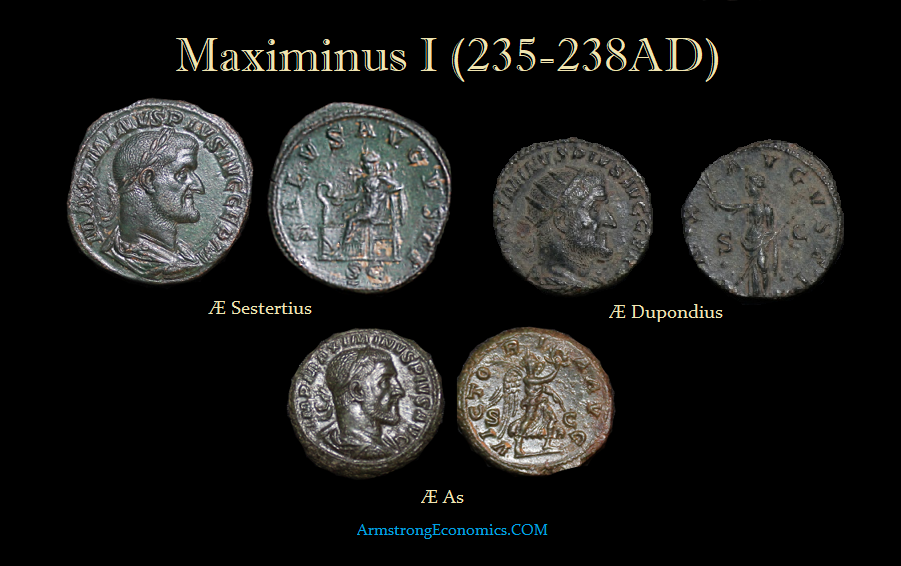
Æ Sestertius 21.65 grams
Æ Dupondius 10.43 grams
Æ As
EGYPT
Æ Tetradrachm, Egypt (14.2 grams)
Barbarous Imitation
This is a very curious, contemporary imitation or irregular issue. This coin was certainly not meant to be an out-and-out forgery, it was struck in what seems to be relatively good silver, and must have had at least a quasi-official function. It is based on Maximinus’s first issue from Rome, which bore a curious composite portrait based on the late heads of Severus Alexander combined with descriptions of the new emperor (no one in Rome knew what Maximinus looked like!). Yet it has to be from an irregular mint because the dies were certainly not cut by an official engraver: not only is the portrait slightly odd, but the legend, while not misspelled, does have curious letters (the Ms are made with what seem to be two inverted Vs – ΛΛ).




